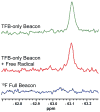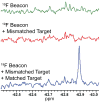Synthesis and Characterization of a Magnetically Active 19F Molecular Beacon
- PMID: 29272914
- PMCID: PMC5821531
- DOI: 10.1021/acs.bioconjchem.7b00671
Synthesis and Characterization of a Magnetically Active 19F Molecular Beacon
Abstract
Gene expression is used extensively to describe cellular characteristics and behaviors; however, most methods of assessing gene expression are unsuitable for living samples, requiring destructive processes such as fixation or lysis. Recently, molecular beacons have become a viable tool for live-cell imaging of mRNA molecules in situ. Historically, beacon-mediated imaging has been limited to fluorescence-based approaches. We propose the design and synthesis of a novel molecular beacon for magnetic resonance detection of any desired target nucleotide sequence. The biologically compatible synthesis incorporates commonly used bioconjugation reactions in aqueous conditions and is accessible for laboratories without extensive synthesis capabilities. The resulting beacon uses fluorine (19F) as a reporter, which is broadened, or turned "off", via paramagnetic relaxation enhancement from a stabilized nitroxide radical spin label when the beacon is not bound to its nucleic acid target. Therefore, the 19F NMR signal of the beacon is quenched in its hairpin conformation when the spin label and the 19F substituent are held in proximity, but the signal is recovered upon beacon hybridization to its specific complementary nucleotide sequence by physical separation of the radical from the 19F reporter. This study establishes a path for magnetic resonance-based assessment of specific mRNA expression, providing new possibilities for applying molecular beacon technology in living systems.
Conflict of interest statement
The authors declare no competing financial interest.
Figures





Similar articles
-
Applications of Hairpin DNA-Functionalized Gold Nanoparticles for Imaging mRNA in Living Cells.Methods Enzymol. 2016;572:87-103. doi: 10.1016/bs.mie.2016.03.019. Epub 2016 Apr 12. Methods Enzymol. 2016. PMID: 27241751
-
Capillary electrophoresis and fluorescence studies on molecular beacon-based variable length oligonucleotide target discrimination.Electrophoresis. 2003 Jan;24(1-2):70-7. doi: 10.1002/elps.200390033. Electrophoresis. 2003. PMID: 12652574
-
Hybridization of 2'-O-methyl and 2'-deoxy molecular beacons to RNA and DNA targets.Nucleic Acids Res. 2003 Mar 15;31(6):5168-74. Nucleic Acids Res. 2003. PMID: 12669716
-
Molecular beacons: an optimal multifunctional biological probe.Biochem Biophys Res Commun. 2008 Sep 5;373(4):457-61. doi: 10.1016/j.bbrc.2008.05.038. Epub 2008 May 19. Biochem Biophys Res Commun. 2008. PMID: 18489905 Review.
-
Quenched probes for highly specific detection of cellular RNAs.Trends Biotechnol. 2005 May;23(5):225-30. doi: 10.1016/j.tibtech.2005.03.007. Trends Biotechnol. 2005. PMID: 15865999 Review.
Cited by
-
Incorporation and Utility of a Responsive Ribonucleoside Analogue in Probing the Conformation of a Viral RNA Motif by Fluorescence and 19 F NMR Spectroscopy.Chembiochem. 2022 Feb 4;23(3):e202100601. doi: 10.1002/cbic.202100601. Epub 2021 Dec 7. Chembiochem. 2022. PMID: 34821449 Free PMC article.
-
Advances in RNA Labeling with Trifluoromethyl Groups.Chemistry. 2023 Oct 26;29(60):e202302220. doi: 10.1002/chem.202302220. Epub 2023 Sep 20. Chemistry. 2023. PMID: 37534701 Free PMC article.
-
Small-molecule fluorescent probes and their design.RSC Adv. 2018 Aug 14;8(51):29051-29061. doi: 10.1039/c8ra02297f. eCollection 2018 Aug 14. RSC Adv. 2018. PMID: 35547972 Free PMC article. Review.
-
Synthesis and applications of theranostic oligonucleotides carrying multiple fluorine atoms.Theranostics. 2020 Jan 1;10(3):1391-1414. doi: 10.7150/thno.37936. eCollection 2020. Theranostics. 2020. PMID: 31938071 Free PMC article. Review.
References
-
- Tyagi S, Kramer FR. Molecular beacons: probes that fluoresce upon hybridization. Nat Biotechnol. 1996;14:303–308. - PubMed
-
- Peng XH, Cao ZH, Xia JT, Carlson GW, Lewis MM, Wood WC, Yang L. Real-time detection of gene expression in cancer cells using molecular beacon imaging: new strategies for cancer research. Cancer Res. 2005;65:1909–1917. - PubMed
Publication types
MeSH terms
Substances
Grants and funding
LinkOut - more resources
Full Text Sources
Other Literature Sources

